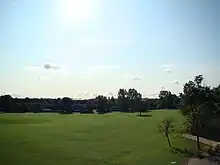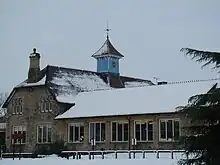Royal Latin School
The Royal Latin School (RLS) is a co-educational grammar school in Buckingham, England. It has continually existed for over six hundred years; receiving a Royal Charter in this time and moving premises three times. In September 2011 the school became an academy.[1] It takes children from the age of 11 through to the age of 18 and has over 1260 pupils, including a sixth form of 390 pupils. Every year it takes in 174 pupils, either those who passed the 11+ or were qualified by a Selection Review panel. It maintains a staff of just over 160. In September 2003 the school was designated by the Department for Education and Skills (DfES) as a specialist school in science. It was successfully re-designated in 2007 and achieved a second specialism as a training school.
| Royal Latin School | |
|---|---|
.jpg.webp) | |
| Address | |
Chandos Road , , MK18 1AX | |
| Coordinates | 51°59′36″N 0°59′10″W |
| Information | |
| Type | Academy Grammar School |
| Motto | "Alle may God amende" (Ruding 1423) "High expectations for all" (1993) |
| Religious affiliation(s) | Christian |
| Established | c. 1423 |
| Founder | King Edward VI (by royal charter) |
| Specialist | Science College, Training school |
| Department for Education URN | 137344 Tables |
| Ofsted | Reports |
| Chair of Governors | Phil Dart |
| Staff | 160+ |
| Gender | Coeducational |
| Age | 11 to 18 |
| Enrolment | 1260+ |
| Sixth form students | 390+ |
| Houses | 6 |
| Colour(s) | Black and Red |
| Publication | The Latin |
| Website | www |



Since the county's boundary adjustments of 1974 placed Eton College in Berkshire, the Royal Latin School claims the distinction of being the sole Pre-Reformation grammar school in the county.[2] The Royal Latin School was graded as good in the 2023 report by OFSTED.[3]
History
The school's earliest recorded reference occurs in 1423. A very small establishment at first, the school taught only six poor boys.
Although Buckingham's citizens supported Catherine of Aragon and her daughter Mary Tudor, and were opposed to the Reformation, the Chantry Chapel in which the Royal Latin School was based, rather than being destroyed by Edward VI (as many similar establishments were) was instead converted into the Royal Latin School. King Edward VI granted a charter for the school, for 30-40 pupils, in 1548 with an endowment of £10 and with 12 trustees.[4] A major fire in 1696 destroyed the Master's House which was rebuilt by Alexander Denton, complete with a garden.[5]
The Chantry Chapel dedicated to St John the Baptist and Thomas Becket had an original Romanesque doorway, and served as the main schoolroom. An early 19th-century Master was the Oxford-educated aristocrat Rev William Eyre MA, the vicar of Padbury. It remained the home of the Royal Latin School until 1907 when Buckinghamshire County Council provided major new buildings for the school in Chandos Road, now the site of Grenville School and did so again in 1963, when the school moved to Brookfield House, formerly The Mount. Numerous extensions in 1963 were opened by Queen Elizabeth the Queen Mother, with further extensions being gradually added over the next few decades. The warm brown brickwork of the 1963 extensions complements the stone-built structure of the earlier buildings, the whole is enhanced by its parkland setting on the outskirts of Buckingham.[4] Brookfield House and its grounds have been expanded over recent years to accommodate the growing size of the school and the fact that many of the older buildings, given the larger number of students, were becoming inadequate for use on such a large scale.
In 2006, the U15 rugby side made school history by becoming the first side from the Royal Latin to reach the semi-finals of the Daily Mail Vase, the English schools' annual rugby union cup competition. The U15s surpassed this record in 2013 reaching the final at Twickenham Stadium, where they beat Felsted School 19–13 to win the vase. The U13 girls' team (rugby) won girls nationals in 2015 and were unbeaten in the 2017–18 season.
In 2015, the first of three projects known as the 'RLS 600 Campaign[6]' was completed. This was a two-storey science laboratory with 13 classrooms for expanding further the knowledge of sciences for the students. The next project was a Sports Campus, opened in September 2021. The final project will be an Arts Department, which the school aims to complete before its 600th anniversary in 2023.
School buildings
Brookfield House was formerly the boys' boarding house. It is a former hunting lodge that houses the school offices and reception, the school library, conference room, art department, music department and some science and drama laboratories and rooms. Rotherfield House was formerly the girls' boarding house. It houses the sixth form classrooms and common room, as well as the school lecture theatre, school archives, a computer suite and alumni rooms and offices.
The Main Block, built in 1963 by Fred Pooley, houses the school hall, old gymnasium, stage (both indoor and outdoor) and drama department, student reception, school offices, English department, humanities department and the dining room. There is a separate technology block. New Block houses the mathematics department, the languages department, the economics and business studies department and some science laboratories.
There is a sports hall and a sports campus.
The school's Discovery Centre is a 12-classroom building for sciences that also contains conference rooms. The building was opened on 2 October 2015 by Robert Winston and John Bercow.
The school uses the church of St Peter and St Paul's in Buckingham for its annual carol service and Founder's Day service, which is held on the feast day of St John, the patron saint of the school. The church is also used for various concerts throughout the year.
The Chantry Chapel, the school's former chapel, is now owned by the National Trust and is too small to accommodate the entire school, so all school religious ceremonies take place in the parish church.
Organisation
Houses
Each pupil, upon entrance, is placed into one of six houses, named after founders of the school at various stages in its history. The six houses are:
| Houses | Significance |
|---|---|
| Barton | Involved in founding schools both in the Chantry Chapel and in 1468, a grammar school in Thornton. These were combined to form the Royal Latin School during the 16th century. |
| Denton | Although Isobel Denton was mistakenly claimed to have founded the school during the sixteenth century, in the late 17th century Alexander Denton rebuilt the master's house following a destructive fire. |
| Newton | Gabriel Newton founded Green Coat Schools throughout England including in Buckingham. He provided an annual endowment of £26 which was transferred to the Royal Latin School in 1904. |
| Ruding | John Ruding was awarded the title of Archdeacon of Lincoln and Prebendary of Sutton upon Buckingham in 1471 and was therefore responsible for funding the upkeep of all church-owned buildings including that which subsequently housed the Royal Latin School. |
| Stratton | Stratton left support for the Buckingham Chantry Chapel to support his soul in purgatory when he died in 1268. The chantry priest he funded, later started the school at Buckingham. |
| Verney | As the school grew during the early 20th century it was forced to move from the Chantry Chapel to a new purpose-built site on Chandos Road (now the site of Grenville Combined School), a move made possible by the work of Lady Verney. |
Headmasters
| Dates of office | Name | Date | Name |
|---|---|---|---|
| 1524–1553 | T. Hawkins (Chantry priest 1524)[7] | 1785–1830 | William Eyre |
| 1553–1569 | Henry Webster | 1830–1855 | Edward Britten |
| 1574–1580 | Alexander Sheppard | 1855–1858 | Thomas Laugharne[8] |
| 1580–1592 | Thomas Potter | 1858–1861 | Vacant post |
| 1592–1603 | James Smith | 1861–1869 | Thomas Owain Jones |
| 1603–1609 | Robert Tomlyns | 1869–1871 | Louis Borissow (son of Christian Ignatius Borissow) |
| 1609–1625 | Richard Earle | 1871–1891 | Thomas Cockram |
| 1625–1632 | Richard Home | 1891–1895 | Robert C. MacCulloch |
| 1633–1638 | Thomas Dutton | 1895–1896 | Thomas Cockram |
| 1638–1660 | Edward Ummant | 1896–1908 | Walter Matthew Cox |
| 1660–1664 | Thomas Stephens | 1908–1931 | William Fuller |
| 1664–1665 | William Warters | 1931–1935 | Maurice Walton Thomas |
| 1665–1682 | Roger Griffiths (father of Mary Pix) | 1936–1939 | Stanley Arthur Dyment |
| 1682–1684 | Thomas Dalby | 1939–1941 | Henry Bert Toft |
| 1685–1690 | Thomas Yeomans | 1941-1941 | Donald E. Morgan |
| 1690–1691 | Mark Noble | 1942–1945 | Charles Foster |
| 1691–1696 | Robert Styles | 1945–1948 | Henry Bert Toft |
| 1709–1715 | Samuel Foster | 1948–1979 | George K. Embleton |
| 1715–1723 | Richard Cardwell | 1979–1992 | Peter Luff |
| 1723–1763 | William Halstead | 1992–2005 | Cecilia Galloway |
| 1763–1764 | Vacant post | 2006–2009 | A. Robert Cooper |
| 1764–1785 | James Eyre | 2010-August 2024 | David Hudson |
Old Latins
- Mary Pix, 17th century novelist and playwright
- Cecil Gardner, World War I Royal Air Force pilot[9]
- Shan Morgan, CMG, diplomat and former ambassador to Argentina
- Air Marshal Sir Julian Young, KBE CB, Royal Air Force Chief Engineer[10]
- Craig Pickering, Olympic athlete
- Dan Jones, writer
- Sam Baldock, footballer
- George Baldock, footballer
See also
Footnotes
- "Open academies map and schools submitting applications". Department for Education. Retrieved 7 September 2011.
- Buckinghamshire - 25 years of architecture 1952-1977 Buckinghamshire County Council - Department of Architecture, p.19
- "2023 OFSTED report". Department for Education.
- The Educational Year-book, p. 170, Published by Cassell, Petter & Galpin, 1885
- Carlisle, Nicholas (1818). Concise Description of Endowed Schools. Vol. 1. p. 47.
- "Home". rls600.com. Retrieved 21 September 2017.
- Poornan, Paul: - The Royal Latin School, Buckingham (Marsh Gibbon, Dusty Old Books Ltd, 2001.)
- The Annual Register or A View of the History and Politics of the Year 1856, Published 1857, F. & J. Rivington
- "Buckingham Royal Latin School Memorials". Buckinghamshire Remembers. 2014. Retrieved 3 January 2015.
- "Power of Sport Dinner" (PDF). Latin Life. No. 13. Royal Latin School. p. 13. Retrieved 14 February 2021.
References
- Kettler, Sarah Valente. Trimble, Carole. The Amateur Historians Guide to the Heart of England: Nearly 200 Medieval & Tudor Sites: nearly 200 Medieval & Tudor sites two hours or less from London